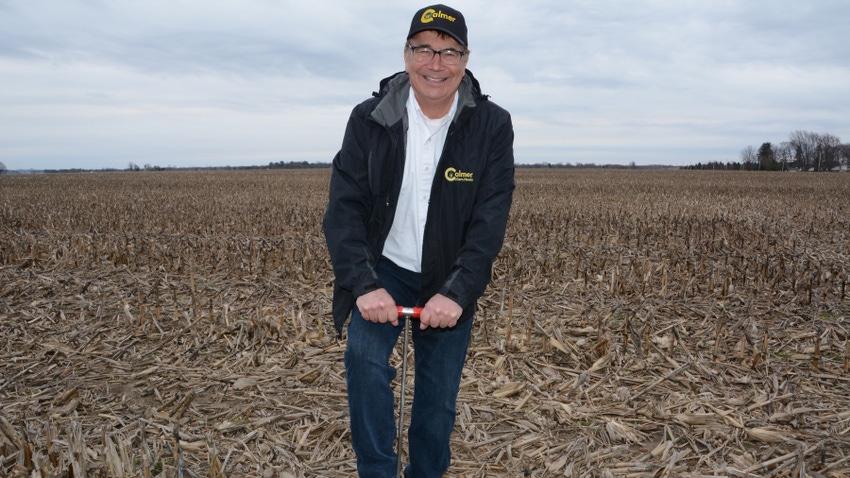
Marion Calmer has no-tilled his silt-loam and clay-loam soils in northwest Illinois for 30 years, and he is still no-tilling. But he made a discovery during the past five years that has him rethinking the best way to apply and maintain major nutrients such as phosphorus and potassium in no-till. Going forward, he will try different approaches to solve a stratification problem he uncovered. Far more of his nutrients are in the top 2 inches than in the 6- to 8-inch zone.
Calmer farms near Alpha, Ill. He does so much on-farm research that he formed the Calmer Independent Agronomic Research Center. He and his family also own and operate Calmer Corn Heads, near Lynn Center, Ill.
“We pay lots of attention to horizontal variability in the soil when we lay out soil sampling zones,” Calmer says. “I began wondering about vertical variability. Are nutrients like P and K evenly distributed throughout the top 8 inches below the surface, or are they higher near the surface and lower down 6 to 8 inches, where roots continually pump out nutrients to feed the crop?”
Soil sampling inch by inch
To find out, Calmer obtained a soil probe where the top flips open to remove the core. “That made it easy to take a buck knife and slice an 8-inch core into eight 1-inch sections,” he explains. “I label bags from zero to 1 inch down to 7 to 8 inches, then put each inch in the bag where it belongs. It takes time to pull enough cores, but it’s effective.”
Sure enough, when results came back, Calmer found even more variation and stratification than he expected. In no-till fields where P and K were applied on top for 14 years straight, soil-test levels for phosphorus were about four times higher in the top 2 inches vs. at 6 to 8 inches. Potassium levels in those corresponding zones were about three times higher nearer to the surface, as well.
Yield impact
So, Calmer pulled out a moldboard plow and plowed a 1.4-acre plot in a field with several side-by-side test strips. Using an undersized tractor, soil was turned about 90 degrees rather than totally inverted. He leveled the soil and tested again.
“This time we saw higher test levels at 2 to 4 inches, compared to both higher and lower levels,” he says. “But levels in the middle range were only about 40% higher than those at the top or bottom. The graph for potassium looked similar. We obviously achieved some mixing.”
He compared soybean yields on that 1.4 acres vs. neighboring plots still in long-term no-till in 2022. Yield where he planted on the moldboard-plowed strip was 9 bushels per acre better.
“We don’t know how much of that yield increase was due to better distribution of nutrients,” he says. “Some people think carbon release and introducing more oxygen are involved, too.
“We will grow corn there this year and report results. At the same time, we’re experimenting with ways to get mixing without moldboard plowing, and to place nutrients deeper in the soil during application of commercial fertilizer.”
What others think
Mike Starkey, Brownsburg, Ind., a friend of Calmer’s, has no-tilled for a long time too. A primary difference is that on his silt-loam timber soils, he’s used cover crops for the past 15 years, while Calmer has not. Starkey wanted to see if his long-term no-till and cover crop fields were also stratified. He asked Mark Truster of Reynolds Agronomy to sample both a lighter organic matter and an even lighter, reddish soil on rises in the field.
The samples were separated and analyzed in 2-inch segments, from zero to 2 inches through 8 to 10 inches. There were differences, with levels tending to be higher near the top, but the differences weren’t nearly as great as in Calmer’s soil, Starkey reports.
Nutrient levels at 0 to 2 inches tended to be 30% to 50% higher than at 6 to 8 inches, not three to four times higher, as in Calmer’s case. In fact, while levels for phosphorus remained low at 8 to 10 inches, readings for potassium picked back up in that range, moving near to or even higher than readings at 0 to 2 and 2 to 4 inches.
“I believe our cover crops may be helping distribute nutrients,” Starkey says. “And if plowing once does increase yields, I believe more is going on than just better distribution of nutrients.”
Instead, Starkey and other agronomists suggest that increased mineralization due to introducing oxygen through plowing may attribute to more nutrient availability, and higher yields the following season. Many, however, suspect these effects are not sustainable over time.
Test for nutrient stratification yourself
Meanwhile, Calmer will be looking for answers. He intends to continue his research efforts into nutrient stratification, searching for ways to better distribute nutrients within the vertical no-till soil profile.
He encourages other no-tillers to check their own fields for stratification. To that end, Calmer will send a soil probe with a top that opens to anyone who contacts his company. Call 309-629-9000 and ask about receiving a soil probe, or email [email protected].
“I’m interested in seeing what others find out, and if they have a stratification problem,” he says. “It’s much easier to do vertical testing and separate 1-inch segments at different depths for testing with a probe where the top flips open and you can easily measure and slice up the core.”
About the Author(s)
You May Also Like




